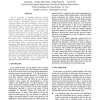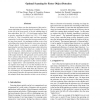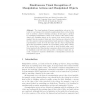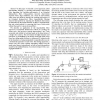111 search results - page 19 / 23 » A generic fisheye camera model for robotic applications |
FGR
2004
IEEE
13 years 11 months ago
2004
IEEE
Due to variations of lighting conditions, camera hardware settings, and the range of skin coloration among human beings, a pre-defined skin-color model cannot accurately capture t...
CVPR
2009
IEEE
14 years 2 months ago
2009
IEEE
Recent years have seen the development of fast and accurate algorithms for detecting objects in images. However, as the size of the scene grows, so do the running-times of these a...
ECCV
2008
Springer
14 years 9 months ago
2008
Springer
Abstract. The visual analysis of human manipulation actions is of interest for e.g. human-robot interaction applications where a robot learns how to perform a task by watching a hu...
CVPR
2011
IEEE
13 years 3 months ago
2011
IEEE
Scene understanding from a monocular, moving camera is a challenging problem with a number of applications including robotics and automotive safety. While recent systems have show...
ICRA
2002
IEEE
14 years 20 days ago
2002
IEEE
—In this paper we describe a novel approach, called improbability filtering, to rejecting false-positive observations from degrading the tracking performance of an Extended Kalma...




